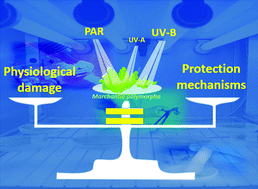Photosynthetically-active radiation, UV-A and UV-B, causes both common and specific damage and photoprotective responses in the model liverwort Marchantia polymorpha subsp. ruderalis†
Abstract
We studied the effects of different radiation treatments on the physiology and UV-absorbing compounds of the model liverwort Marchantia polymorpha subsp. ruderalis. Starting from gemmae, samples were exposed to five radiation treatments: low photosynthetically active radiation (PAR), low PAR+ UV-A, low PAR + UV-B, low PAR + UV-A + UV-B, and high PAR. After 35 days, the maximum quantum yield of photosystem II was similar between treatments, which suggested comparable photoinhibition and physiological vitality, also supported by results showing an unchanged chlorophyll a/b ratio and only slight changes in growth. However, the total contents of both chlorophylls and carotenoids decreased in the UV radiation treatments and, more strongly, in the high-PAR samples, suggesting mainly PAR-dependent damage to the photosynthetic pigments. The xanthophyll index (antheraxanthin + zeaxanthin)/(violaxanthin + antheraxanthin + zeaxanthin) was only increased in the high-PAR samples, indicating an increase in photoprotection through nonphotochemical dissipation of the excess energy. The sclerophylly index (the ratio between the thallus dry mass and surface area) was increased in the UV-B-exposed samples, suggesting a UV-induced structural protection. Only the UV-B-exposed samples showed DNA damage. Several apigenin and luteolin derivatives were found in the methanol-soluble vacuolar fraction of the liverwort and p-coumaric and ferulic acids in the methanol-insoluble cell wall-bound fraction. Most individual soluble compounds, the bulk level of soluble compounds, and chalcone synthase expression increased in UV-B-exposed samples, whereas individual insoluble compounds increased in the samples exposed to only PAR. Principal components analysis summarized these responses, showing the strong influence of both UV-B and PAR levels on the physiology and UV protection of the samples.

- This article is part of the themed collection: Plant responses to UV


 Please wait while we load your content...
Please wait while we load your content...